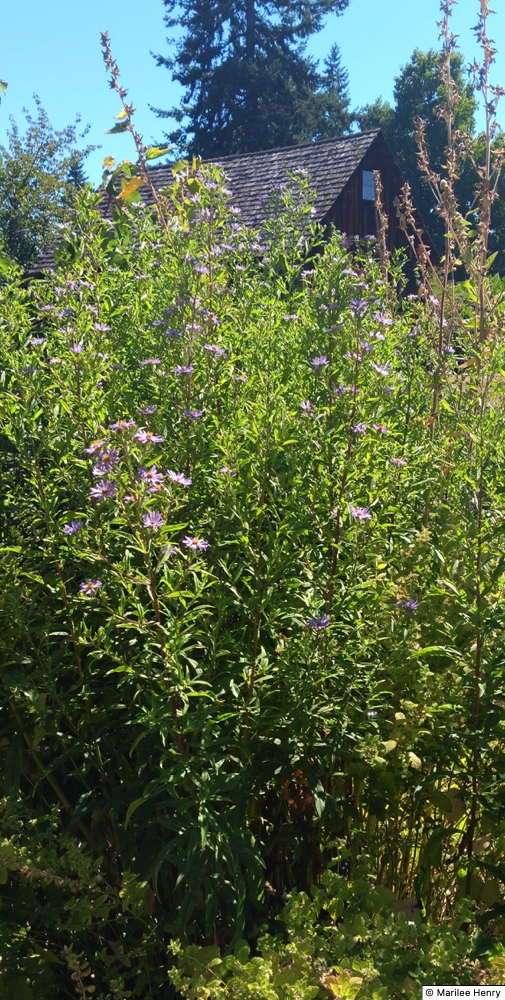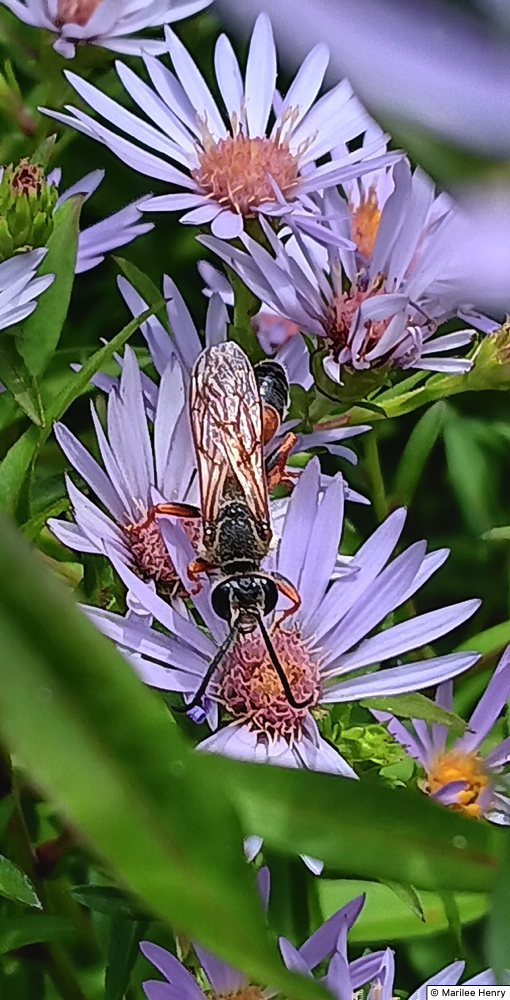 at McAuliffe Park, Kirkland |
 in Finn Hill urban garden, Kirkland |
by Marilee Henry
 at McAuliffe Park, Kirkland |
 in Finn Hill urban garden, Kirkland |
Toward the end of summer most of our native plants still in bloom are in the sunflower family Asteraceae, making them very valuable late-season food sources for pollinators. This month's spotlight is on Douglas' aster, native to western North America but named after the famous Scottish botanist David Douglas who collected plant specimens in this region in the early 1800's.
Douglas' aster (Symphyotrichum subspicatum) is one of Washington's most frequently encountered native Asteraceae species, occurring on both sides of the Cascades in a variety of environments such as meadows, moist streambanks, coastal bluffs, and forest openings from low to mid-level elevations. It ranges from Alaska's Aleutian Islands south into California and eastward into Idaho and Montana.
This green leafy perennial can reach 4 feet in height, with multiple branching stems topped with bluish-purple and gold daisy-like flowerheads. Alternate lance-shaped leaves, smooth-edged or shallowly toothed, grow up to 4 inches in length along the erect stems. As with many species in the sunflower family, a Douglas' aster flowerhead is composed of two different types of individual flowers: compact bisexual disk flowers packed into the center, and strap-like female ray flowers radiating outwards toward the edge. When plucking petals from a daisy chanting "...he/she/they loves me…loves me not…" you are pulling out the ray flowers.
Hardy and easy to grow, Douglas' aster is a perfect choice for urban gardens as well as restoration projects. Though it prefers full sun with slightly moist soil conditions and good drainage, it can adapt to partial shade, clay or silty soils, and moderate drought once established. Tolerance for saline environments allows it to populate coastal lowlands and bluffs. It is at home in a wide range of moisture regimes from wet and occasionally flooded rain gardens and bioswales to drier sunny borders and even rock gardens. Large swaths of goldenrod and Douglas' aster look gorgeous together against a fence or in a border since they thrive in similar conditions and overlap in their bloom times of August through September.
This species has many wildlife benefits; its blooms attracting numerous native bees, butterflies, moths, syrphid flies, hummingbirds, and other important pollinators. It is host to the larvae of several butterflies including the painted lady, northern crescent, and field crescent, and to the Isabella tiger moth's familiar black and orange caterpillars known as "woolybears". Though this plant's greens are considered moderately resistant to browsing, deer may nibble the flowers if other food sources are scarce. However, rabbits can browse plants heavily, so caging young seedlings is advised.
Indigenous peoples made a tea from the whole plant to treat wounds, and a tea from the roots to alleviate fevers and intestinal distress.
Fall is the best time to plant Douglas' aster and any other natives so they can develop robust root systems during winter when above-ground growth has ceased. Since this species needs to be cross-pollinated, be sure to place at least three individuals together, preferably where they can eventually form a large clump as they spread slowly by rhizomes. If you have clay or silty soil, amending it with sand or organic compost can help to improve drainage. Like most native species, Douglas' aster does not need heavy fertilizing. One to two inches of compost or leaf mulch on top of the soil each year will slowly break down to add necessary nutrients.
Douglas' aster is easily grown from seed collected in late fall when the flowerheads have turned into little fuzzballs. Even though they do not require cold stratification for germination, seeds planted in fall one to two months before the first hard frost have a better chance of producing flowers the following summer than if planted in spring. More details for planting seeds can be read here.
Be sure to leave the stems and seedheads on the plants throughout the winter as they provide food for hungry birds, refuges for bees and other insects during the cold season, and soft nesting material come spring!
Always remember, "YOU are nature's best hope!" - Doug Tallamy, author of "Nature's Best Hope", "Bringing Nature Home", and "How Can I Help? Saving Nature with Your Yard".
Marilee Henry
Kirkland Community Wildlife Habitat Team Member, Washington Native Plant Society (WNPS) Native Plant Steward, Green Kirkland Steward, Finn Hill Neighborhood Alliance Contributor
September Plant Sales and Events:
9/6/2025 Oxbow Farm & Conservation Center Fall Plant Sale, 10am-4pm
9/13/2025 Arboretum Foundation Fall Plant Sale, 10am - 2pm
9/14/2025 Washington Native Plant Society Central Puget Sound Chapter with WSU Master Gardener Foundation of King County: Cool Plants, Hot Topics, Plant Sale, and Talks. 9:30am - 4pm, Bellevue Botanical Gardens, map and schedule details here, and here.
9/17/2025 WNPS Salal Chapter Plant Sale, online sales open 10am, plant pickup near Mt Vernon 9/26-27/2025. Details and plant list link here.